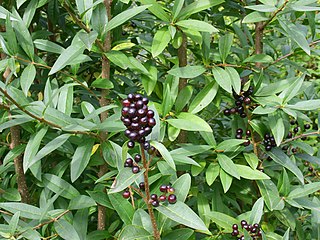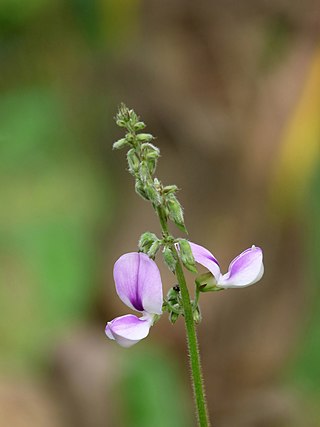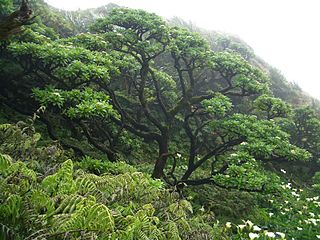
Saccharum is a genus of tall perennial plants of the broomsedge tribe within the grass family.

A privet is a flowering plant in the genus Ligustrum. The genus contains about 50 species of erect, deciduous or evergreen shrubs, sometimes forming small or medium-sized trees, native to Europe, north Africa, Asia, many introduced and naturalised in Australasia, where only one species, Ligustrum australianum, extends as a native into Queensland. Some species have become widely naturalized or invasive where introduced. Privet was originally the name for the European semi-evergreen shrub Ligustrum vulgare, and later also for the more reliably evergreen Ligustrum ovalifolium and its hybrid Ligustrum × ibolium used extensively for privacy hedging, though now the name is applied to all members of the genus. The generic name was applied by Pliny the Elder to L. vulgare. It is often suggested that the name privet is related to private, but the OED states that there is no evidence to support this.

Pueraria is a genus of 15–20 species of legumes native to south, east, and southeast Asia and to New Guinea and northern Australia. The best known member is kudzu, also called Japanese arrowroot. The genus is named after 19th century Swiss botanist Marc Nicolas Puerari.

Lespedeza is a genus of some 45 species of flowering plants in the pea family (Fabaceae), commonly known as bush clovers or Japanese clovers (hagi). The genus is native to warm temperate to subtropical regions of eastern North America, eastern and southern Asia and Australasia.

The flora of Saint Helena, an isolated island in the South Atlantic Ocean, is exceptional in its high level of endemism and the severe threats facing the survival of the flora. In phytogeography, it is in the phytochorion St. Helena and Ascension Region of the African Subkingdom, in the Paleotropical Kingdom.

Hypocalymma robustum, the Swan River myrtle, is a species of shrub in the myrtle family Myrtaceae. It is endemic to the south west region of Western Australia.

Campylotropis is a genus of flowering plants in the legume family, Fabaceae. It includes 41 species of shrubs native to Asia, ranging from the Himalayas to Indochina, China, Taiwan, Mongolia, and Korea, as well as Java and the Lesser Sunda Islands. Typical habitats include seasonally-dry tropical montane forests to temperate forest, woodland, and bushland. The genus belongs to subfamily Faboideae.

Dendrolobium is a genus of flowering plants in the legume family, Fabaceae. It belongs to the subfamily Faboideae. It includes 21 species of mostly trees and shrubs and rarely herbs. Species range from eastern Africa to Madagascar, India, Indochina, southern China, Malesia, Papuasia, northern and western Australia, and the southwestern Pacific. Typical habitats include seasonally-dry tropical forest and woodland, bamboo thickets, and grassland.

Hylodesmum is a genus of flowering plants in the family Fabaceae, sometimes called ticktrefoils or tick-trefoils. It is sometimes treated as part of Desmodium. It includes 16 species native to eastern North America, sub-Saharan Africa, Yemen, south, southeast, and eastern Asia, Malesia, and New Guinea.
Leptodesmia is a genus of flowering plants in the legume family, Fabaceae. It belongs to the subfamily Faboideae. It includes four species ranging from Madagascar and the Comoros to the Indian subcontinent, Indochina, China, Japan, Malesia, New Guinea, and Queensland.

Uraria is a genus of plants in the legume family, Fabaceae. It includes 24 species of shrubs and subshrubs native to sub-Saharan Africa, the Indian Subcontinent, Indochina, China, Malesia, Papuasia, Australia, and the South Pacific. Typical habitats are seasonally-dry tropical woodland or grassland. It belongs to the subfamily Faboideae and the tribe Desmodieae.
Hiroyoshi Ohashi is a botanist formerly at the University of Tokyo and Tohoku University. He began publishing on Japanese Arisaema in the early 1960s. He published a couple of miscellaneous notes on Arisaema in 1963 and 1964 and these were followed by a revision of the genus for Japan jointly published in 1980 with J. Murata, and by the Araceae treatment for the Wildflowers of Japan.

The tribe Desmodieae is one of the subdivisions of the plant family Fabaceae. It is composed of two subtribes, Desmodiinae and Lespedezinae. Recent phylogenetics has this tribe nested within tribe Phaseoleae.

Tadehagi triquetrum is a species of flowering plant in the family Fabaceae. It belongs to the subfamily Faboideae. The species has two subspecies with the nominate one, but sometimes they given full species status by some authors. The maximum height of this shrub tree is 3m. Leaves alternate, linear-oblong, ovate with a tapering tip. Flowers show raceme inflorescence type, which are small, pale purplish in color. The fruit is a hairy legume. It is widespread in all South Asian, East Asian, and Southeast Asian countries.
Pleurolobus is a genus of flowering plants in the pea family (Fabaceae). It includes six species, which range across sub-Saharan Africa, Yemen, the Indian Subcontinent, Southeast Asia, New Guinea, Micronesia, and Australia.
Brachypterum is a genus of flowering plants in the pea family (Fabaceae). It includes eleven species, which range from the Indian Subcontinent through Indochina, southern China, Malesia, New Guinea, and eastern Australia.
Prasophyllum robustum, commonly known as the robust leek orchid, is a species of orchid endemic to Tasmania. It has a single tubular, green leaf and up to thirty greenish-brown flowers with a white labellum. It is only known from a single population of about fifty plants, its numbers having been reduced by land clearing.

Grona is a genus in the flowering plant family Fabaceae. Its native range is worldwide tropics and subtropics.
Harashuteria is a genus of flowering plants in the legume family (Fabaceae). It includes a single species, Harashuteria hirsuta, a climbing perennial native to southeastern Asia, ranging from Nepal through Indochina to south-central China and Hainan.
Huangtcia is a genus of flowering plants in the legume family, Fabaceae. It includes two species of shrubs or subshrubs native to southeastern Asia, ranging from Nepal through eastern India and Indochina to south-central China, and to Hainan, Taiwan, and Java.













